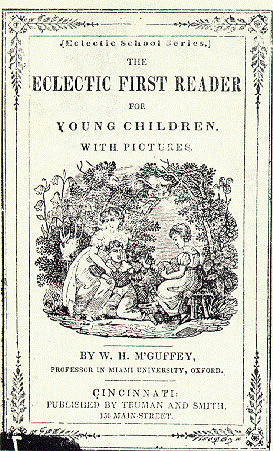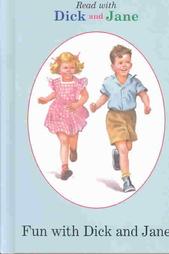Whole language is a philosophy of reading and a discredited educational method originally developed for teaching literacy in English to young children. The method became a major model for education in the United States, Canada, New Zealand, and Great Britain in the 1980s and 1990s, despite there being no scientific support for the method's effectiveness. It is based on the premise that learning to read English comes naturally to humans, especially young children, in the same way that learning to speak develops naturally.

Phonics is a method for teaching people how to read and write an alphabetic language. It is done by demonstrating the relationship between the sounds of the spoken language (phonemes), and the letters or groups of letters (graphemes) or syllables of the written language. In English, this is also known as the alphabetic principle or the alphabetic code.

The Eclectic Readers were a series of graded primers for grade levels 1–6. They were widely used as textbooks in American schools from the mid-19th century to the early 20th century, and are still used today in some private schools and homeschooling.

Dick and Jane are the two main characters created by Zerna Sharp for a series of basal readers written by William S. Gray to teach children to read. The characters first appeared in the Elson-Gray Readers in 1930 and continued in a subsequent series of books through the final version in 1965. These readers were used in classrooms in the United States and in other English-speaking countries for nearly four decades, reaching the height of their popularity in the 1950s, when 80 percent of first-grade students in the United States used them. Although the Dick and Jane series of primers continued to be sold until 1973 and remained in use in some classrooms throughout the 1970s, they were replaced with other reading texts by the 1980s and gradually disappeared from school curricula.
Zerna Addas Sharp was an American educator and book editor who is best known as the creator of the Dick and Jane series of beginning readers for elementary school-aged children. Published by Scott, Foresman and Company of Chicago, Illinois, the readers, which described the activities of her fictional siblings, "Dick," "Jane," "Sally," and other characters, were widely used in schools in the United States and many other English-speaking countries for nearly forty years. The series, which included such titles as We Look and See, We Come and Go, We Work and Play, and Fun with Dick and Jane, among others, was marketed until 1973 and used the look-say method of teaching reading.
The National Reading Panel (NRP) was a United States government body. Formed in 1997 at the request of Congress, it was a national panel with the stated aim of assessing the effectiveness of different approaches used to teach children to read.
Reading comprehension is the ability to process written text, understand its meaning, and to integrate with what the reader already knows. Reading comprehension relies on two abilities that are connected to each other: word reading and language comprehension. Comprehension specifically is a "creative, multifaceted process" dependent upon four language skills: phonology, syntax, semantics, and pragmatics.

Synthetic phonics, also known as blended phonics or inductive phonics, is a method of teaching English reading which first teaches the letter sounds and then builds up to blending these sounds together to achieve full pronunciation of whole words.
HESS International Educational Group is the single largest private provider of English education in Taiwan. Hess has an estimated 60,000 students enrolled. Founded in 1983 by Joseph Chu and Karen Hess, it has become a large business, with schools across the island. Hess also provides books and resources to other English schools across Asia to teach English as a foreign language, and has a chain of bookstores, which was founded in 1990. In addition to the ROC, Hess also has branches in Singapore, China, and South Korea as well as connections to Japan.
Accelerated Reader is a website used to assist students with reading skills. It is a digital program that helps students and teachers manage and monitor independent reading practice in both English and Spanish. Students pick a book at their own level and read it at their own pace. When students finish the book, they take a short quiz on the computer to check their understanding. As students read and take quizzes, they points depending how difficult the book is; the more difficult the book is, the more points the students receive. It also tracks the students' progress towards their individualized Accelerated Reader goals.
Decodable text is a type of text often used in beginning reading instruction. Decodable texts are carefully sequenced to progressively incorporate words that are consistent with the letters and corresponding phonemes that have been taught to the new reader. Therefore, with this type of text new readers can decipher words using the phonics skills they have been taught. For instance, children could decode a phrase such as “Pat the fat rat” if they had been taught the letter-sound associations for each letter—that 'p' stands for the sound /p/, 'a' for the sound /a/, etc.
Guided reading is "small-group reading instruction designed to provide differentiated teaching that supports students in developing reading proficiency". The small group model allows students to be taught in a way that is intended to be more focused on their specific needs, accelerating their progress.
High frequency sight words are commonly used words that young children are encouraged to memorize as a whole by sight, so that they can automatically recognize these words in print without having to use any strategies to decode. Sight words were introduced after whole language fell out of favor with the education establishment.
The Dolch word list is a list of frequently used English words, compiled by Edward William Dolch, a major proponent of the "whole-word" method of beginning reading instruction. The list was first published in a journal article in 1936 and then published in his book Problems in Reading in 1948.
Balanced literacy is a theory of teaching reading and writing the English language that arose in the 1990s and has a variety of interpretations. For some, balanced literacy strikes a balance between whole language and phonics and puts an end to the so called reading wars. Others say balanced literacy, in practice, usually means the whole language approach to reading.
Analytic phonics refers to a very common approach to the teaching of reading that starts at the word level, not at the sound (phoneme) level. It does not teach the blending of sounds together as is done in synthetic phonics. One method is to have students identify a common sound in a set of words that each contain that same sound. For example, the teacher and student discuss how the following words are alike: pat, park, push and pen. Analytic phonics is often taught together with levelled-reading books, look-say practice, and the use of aids such as phonics worksheets.

Reading is the process of taking in the sense or meaning of letters, symbols, etc., especially by sight or touch.
A word sort is a developmental word study activity espoused by the Words Their Way curriculum as written by Donald R. Bear, Marcia Invernizzi, Shane Templeton, and Francine Johnston. The activity focuses students' attention on critical features of words, namely sound, pattern, and meaning.
Why Johnny Can't Read—And What You Can Do About It is a 1955 book-length exposé on American reading education by Rudolf Flesch. It was an immediate bestseller for 37 weeks and became an educational cause célèbre. In this book, the author concluded that the whole-word (look-say) method was ineffective because it lacked phonics training. In addition, Flesch was critical of the simple stories and limited text and vocabulary in the Dick and Jane style readers that taught students to read through word memorization. Flesch also believed that the look-say method did not properly prepare students to read more complex materials in the upper grade levels.
Arther Storrey Trace Jr. was an author, educator, educational critic and reformer, and academic professor. Trace was best known as the author of What Ivan Knows that Johnny Doesn't (1961), published by Random House during the Sputnik era, at the height of the Cold War with the Soviet Union. In this book, he sought to upend the then commonly held opinion that although the United States seemed to lag behind the Soviet Union in the teaching of science and mathematics, it was superior in the teaching of the humanities.





